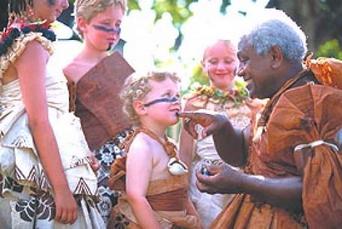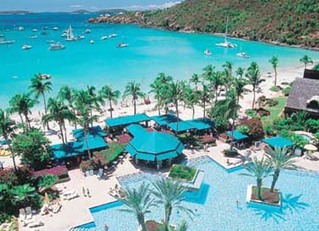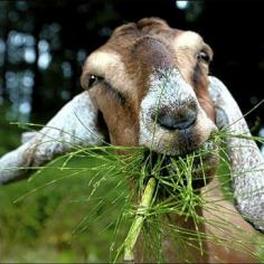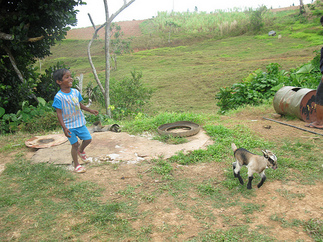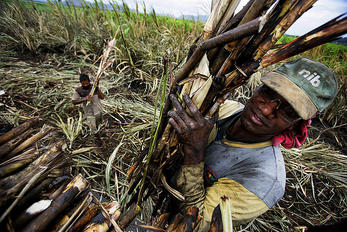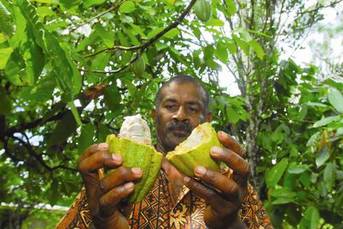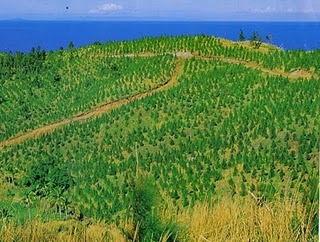CURRENT THREATS TO CONSERVATION
Conservation efforts of Fijian Tropical Dry Forests are currently unsatisfactory. Most of Fiji’s conservation efforts have been put toward preserving the rainforest, coral reefs, and beaches, while the dry forest for the most part has been neglected. A few small patches of dry forest remain on Vanua Levu, Viti Levu, Yaduataba Island, and on small islands in the Mamanuca and Yasawa Groups, complicating conservation efforts. However, with the exception of Yadua Taba, none of the remaining dry forest areas are protected in reserves and there is a danger that these areas will be completely destroyed, through fire or clearing, before any effort is made to survey or save them.
Most of the Fijian dry forest areas face a variety of threats, including grazing, fire, forest clearing and invasive species. However, perhaps more critical, is the lack of knowledge about the composition of some of its flora and fauna. New taxa and records have been discovered in the last 10 years; yet, still not enough is known about soil conditions and the distribution of potentially endangered species. Without a detailed picture of all of its inhabitants, it is difficult to spark interest in or carry out conservation plans. Every effort should be made to survey remaining forests in these areas to identify the most diverse and extensive communities remaining in the many Tropical Dry Forest fragments and to start the process leading to their protection (Dahl 1980).
Most of the Fijian dry forest areas face a variety of threats, including grazing, fire, forest clearing and invasive species. However, perhaps more critical, is the lack of knowledge about the composition of some of its flora and fauna. New taxa and records have been discovered in the last 10 years; yet, still not enough is known about soil conditions and the distribution of potentially endangered species. Without a detailed picture of all of its inhabitants, it is difficult to spark interest in or carry out conservation plans. Every effort should be made to survey remaining forests in these areas to identify the most diverse and extensive communities remaining in the many Tropical Dry Forest fragments and to start the process leading to their protection (Dahl 1980).
POLICY
Conservation of Fiji's Tropical Dry Forest is largely dependent on government policy. Unfortunately, Fiji has had a tumultuous political past since gaining independence from Britain in 1970. Plagued with multiple coup d'tats, the recent constitutional suspension of 2009, and a current military-led regime, Fiji's environmental policy has been at times neglected.
Environmental planning has been plagued with fragmentation , a lack of funding, and is often times outdated. Fiji's government is highly centralized, exercising a top-down form of governance. However, this means that the government has a central bias, often with limited funds to visit the over 100 inhabited islands. As a result, policy can be set without ample knowledge of the area, and the top-down structure often fails, as compliance can be difficult to ensure. Additionally, outdated legislation, some of which still remains from British colonization, has resulted in a lack of utilization in environmental planning. For example, a licensing regime might be put in place, but management plans have been largely ignored. Simiilarly, when a plan is put into place, limited funds or resources are available to review and evaluate the plan.
At the same time, Fiji, which is heavily reliant on tourist revenues, has been consistent in its effort to maintain high levels of tourism. As a result, conservation of the environment is indirectly aided. For example, two military coups occurred in 1987 that greatly deterred tourism to the islands. However, tourist authorities maintained tourist revenue at just 10% below the previous year's revenue.
At the same time, Fiji, which is heavily reliant on tourist revenues, has been consistent in its effort to maintain high levels of tourism. As a result, conservation of the environment is indirectly aided. For example, two military coups occurred in 1987 that greatly deterred tourism to the islands. However, tourist authorities maintained tourist revenue at just 10% below the previous year's revenue.
While Fiji's conservation efforts are not yet adequate, the Fijian government has taken steps toward improvement. Their national environmental policy states that, "Maintenance of Fiji's healthy environment through protection and conservation of its unique features, and the judicious utilization of its resources form an integral part of development". Adhering to these principals, the Ministry of Tourism and Transport created an ecotourism policy in 1999. In it, the government defined the principles of ecotourism and stated the need to expand both ecotourism and village-based tourism, with sustainability as a key principal. Similarly, a series of anti-pesticide use laws have been incorporated into various acts, such as the Forest Act, Pesticide Act, and the Game and Bird Protection Act. One act with a narrow focus is the Bird and Game Protection Act (1923). While this was a well-developed scheme, prohibiting the wounding, killing, selling, exporting, or holding captive protected birds, the schemes penalties of a maximum fine of $50 or 3 months imprisonment are sometimes too low to deter illegal behavior.
To help Fiji and its protection of the environment, various Non-governmental Organization play an important role. Some important organizations are the WWF South Pacific Programme, Fiji Council of Social Services (FIJICOSS), World YMCA, The south Pacific Action Committee on Human Ecology and the Environment (SPACHEE), and the FIJI/GERMAN Agency.
To help Fiji and its protection of the environment, various Non-governmental Organization play an important role. Some important organizations are the WWF South Pacific Programme, Fiji Council of Social Services (FIJICOSS), World YMCA, The south Pacific Action Committee on Human Ecology and the Environment (SPACHEE), and the FIJI/GERMAN Agency.
GRAZING
Fiji's tropical dry forests have come into conflict with the increasing numbers of livestock, including goats and sheep. Interestingly, cattle are not a prominent threat; population numbers continue to decrease, with Minister of Agriculture putting a ban on the killing of female cattle. Instead, the goat (Capra hircus) poses a serious disturbance to dry forest habitat.
Goats are herbivores that can consume a great variety of plants. While they can be beneficial for clearing scrub, the increasing numbers of goats in Fiji have sometimes resulted in overgrazing, altering plants, forest structure and habitat for other animals. Additionally, if the goats become feral they can become vectors of diseases to other animals .
While the goat was domesticated 10,000 years ago, it was possibly introduced by European settlers and have been raised in Fiji since the 1860's. Fiji's agricultural census of 1942 estimated that there were only 27,183 goats. Since then, the number has continued to grow with 187,234 goats in 1991.
One reason for their growing population is because of their economic importance to the country. In 1972, the Fijian government asked United Nations Development Program (Food and Agricultural Program) to help develop their goat industry, using goats as a source of meat. A goat development scheme was born, and thus the government became invested.
The population of goats in Fiji are located largely in the west, with 42% in the Northwestern province of Ba, on Viti Levu. Additionally, many populations are found in areas of sugar cane production. Goat raising is largely practiced by small-holder farmers, and particularly by Indian settlers, who reside in the West.
While the goat was domesticated 10,000 years ago, it was possibly introduced by European settlers and have been raised in Fiji since the 1860's. Fiji's agricultural census of 1942 estimated that there were only 27,183 goats. Since then, the number has continued to grow with 187,234 goats in 1991.
One reason for their growing population is because of their economic importance to the country. In 1972, the Fijian government asked United Nations Development Program (Food and Agricultural Program) to help develop their goat industry, using goats as a source of meat. A goat development scheme was born, and thus the government became invested.
The population of goats in Fiji are located largely in the west, with 42% in the Northwestern province of Ba, on Viti Levu. Additionally, many populations are found in areas of sugar cane production. Goat raising is largely practiced by small-holder farmers, and particularly by Indian settlers, who reside in the West.
DEFORESTATION
Deforestation has been and remains a serious issue in Fiji's tropical dry forest regions and is the largest contributor to why only small patches of dry forest remain in Fiji. Historically, the removal of dry forest occurred over 3500 years ago when the first native Polynesians and Melanesians began to inhabit the islands of Fiji. The forests became even further degraded with British colonization, as land was cleared for commercial agriculture, with an emphasis on sugar cane production. The removal of forested regions continued even after colonization ended; as Fiji's population grew and the need for economic development became more salient, dry forest was cut down for agricultural expansion, logging and urban development. For example, the Fiji government cleared forest from the 1960's to the 1980's to make room for government-sponsored banana, sugar cane and cocoa economic opportunities.
Fijian government policy is an important factor in contributing to deforestation. For example, the government is the sole issuer of timber licenses, which are short term by nature. As a result of this short duration, those with licenses seek to extract as much as much as possible. One possible way to mitigate this extraction is to make longer term licenses, with even heavier regulation. Another issue that contributes to deforestation is Fiji's system of property rights. Forested regions are largely held by indigenous Fijian communities, accounting for 87% of forested areas. Land rights have been a serious issue in domestic politics, and indigenous people often clash with the government over the state of forested regions and how the revenues gained will be distributed.
Deforestation continues to be a problem in Fiji. "Between 1990 and 2010, Fiji lost an average of 3,050 hecates a year." In 1990, there were 861,000 hectares of forest cover. This number has continued to increase; in 2010, 837,000 hectares. Interestingly, if you include planted forests when looking at the amount of forest cover, the amount of forest is increasing. For example, Looking at total forest cover change, in 1999, there was 953,000 hectares of forest. In the years following, forest cover continued to increase. In 2010, there was 1,014,000 hectares of forest. 17% of Fiji's total forest area is planted forest.
Deforestation continues to be a problem in Fiji. "Between 1990 and 2010, Fiji lost an average of 3,050 hecates a year." In 1990, there were 861,000 hectares of forest cover. This number has continued to increase; in 2010, 837,000 hectares. Interestingly, if you include planted forests when looking at the amount of forest cover, the amount of forest is increasing. For example, Looking at total forest cover change, in 1999, there was 953,000 hectares of forest. In the years following, forest cover continued to increase. In 2010, there was 1,014,000 hectares of forest. 17% of Fiji's total forest area is planted forest.
Unfortunately, planted forests are not of the same quality as the destroyed dry forest regions, and these forests are often created for the purpose of extraction. For example, Fiji's Pine Commission has planted extensive pine forests on the western side of the main islands, in grassland areas where dry forest once thrived. These pine forests can host invasive species and are no substitute for the once developed dry forest. When dry forest is destroyed, the species living there lose their habitat and often have no place to go.
While deforestation leads to the loss of habitat for many species, both endemic and otherwise, deforestation also has negative consequences for local people. These forest regions still provide valuable services for the local people, such as items for consumption, and these forests help prevent flooding in the dry forest area (during the wet season, where rain can be as high as levels in the wet regions). Similarly, forests help preserve soil conditions and help prevent erosion. More generally, when forests are cut, large amounts of CO2 can be released. Cutting down tropical forests can contribute to the larger issue of global warming, as on a global scale estimates that deforestation can emit roughly 16% of global warming greenhouse gases.
While deforestation leads to the loss of habitat for many species, both endemic and otherwise, deforestation also has negative consequences for local people. These forest regions still provide valuable services for the local people, such as items for consumption, and these forests help prevent flooding in the dry forest area (during the wet season, where rain can be as high as levels in the wet regions). Similarly, forests help preserve soil conditions and help prevent erosion. More generally, when forests are cut, large amounts of CO2 can be released. Cutting down tropical forests can contribute to the larger issue of global warming, as on a global scale estimates that deforestation can emit roughly 16% of global warming greenhouse gases.
Back to the Top
Sources
ABC. "New strategy for Fiji on deforestation." Radio Australia. N.p., n.d. Web. 2 June 2011.
<http://www.radioaustralia.net.au/pacbeat/stories/200908/s2665623.htm>
Clunie, F. 1985. Seabird nesting colonies of the Ringgold Islands. Domodomo 3
Conservation of Fijan Forests: Building Conservation Landscapes into Forestry Operations and Forest Certification <http://pdf.usaid.gov/pdf_docs/PDACD424.pdf->
Dahl, A.L. 1980. Regional ecosystems survey of the South Pacific area. South Pacific Commission, Noumea, New Caledonia.
Falvey, Lindsay. "Research for Goat Development in Asia: A Management Consultant Viewpoint ." Australian Centre for International Agricultural Research. N.p., n.d. Web. 3 June 2011.
<http://aciar.gov.au/files/node/13298/goat_production_and_research_in_the_tropics_part__16457.pdf>
Fijilive. "Ban on female cattle slaughter Gateway to Fiji, Fiji News. N.p., n.d. Web. 1 June 2011.
<http://www.fijilive.com/news/2011/02/13/30537.Fijilive>
Fiji Forest Information and Data." Mongabay. N.p., n.d. Web. 1 June 2011. <http://rainforests.mongabay.com/deforestation/2000/Fiji.htm#02-types>
Gibbons, J.R.H. 1981. The biogeography of Brachylophus (Iguanidae) including the description of a new species, B. vitiensis, from Fiji. Journal of Herpetology 15:"Terrestrial Ecoregions -- Fiji Tropical Dry Forests (OC0201)." World Wildlife Fund - Wildlife Conservation, Endangered Species Conservation. Web. 24 May 2011. <http://www.worldwildlife.org/wildworld/profiles/terrestrial/oc/oc0201_full.html>.
Keppel, Gunnar , and Marika Tuiwawa. "Dry zone forests of Fiji: Species composition, life history traits, and conservation New Zealand Journal of Botany." New Zealand Journal of Botany 45.4 (2007): 545-563. PrintSmall Ruminant Production Systems in South and Southeast Asia : proceedings of a workshop held in Bogor, Indonesia, 6-10 October 1986. Ottawa, Ont. IDRC, 1987. xii + 414 p.: ill. <http://idl-bnc.idrc.ca/dspace/bitstream/10625/16820/1/71073_p289-310.pdf>
Prasad, Biman C. , and Clement A. Tisdell. Institutions, Economic Performance And Sustainable Development: A Case Study of the Fiji Islands: Nova Science Pub Inc, 2006. Print.
"Tropical Dry Forests of the Pacific - Fiji." Geography Department at UCLA. N.p., n.d. Web. 28 May 2011. <http://www.geog.ucla.edu/tdfpacific/fiji.html>
ABC. "New strategy for Fiji on deforestation." Radio Australia. N.p., n.d. Web. 2 June 2011.
<http://www.radioaustralia.net.au/pacbeat/stories/200908/s2665623.htm>
Clunie, F. 1985. Seabird nesting colonies of the Ringgold Islands. Domodomo 3
Conservation of Fijan Forests: Building Conservation Landscapes into Forestry Operations and Forest Certification <http://pdf.usaid.gov/pdf_docs/PDACD424.pdf->
Dahl, A.L. 1980. Regional ecosystems survey of the South Pacific area. South Pacific Commission, Noumea, New Caledonia.
Falvey, Lindsay. "Research for Goat Development in Asia: A Management Consultant Viewpoint ." Australian Centre for International Agricultural Research. N.p., n.d. Web. 3 June 2011.
<http://aciar.gov.au/files/node/13298/goat_production_and_research_in_the_tropics_part__16457.pdf>
Fijilive. "Ban on female cattle slaughter Gateway to Fiji, Fiji News. N.p., n.d. Web. 1 June 2011.
<http://www.fijilive.com/news/2011/02/13/30537.Fijilive>
Fiji Forest Information and Data." Mongabay. N.p., n.d. Web. 1 June 2011. <http://rainforests.mongabay.com/deforestation/2000/Fiji.htm#02-types>
Gibbons, J.R.H. 1981. The biogeography of Brachylophus (Iguanidae) including the description of a new species, B. vitiensis, from Fiji. Journal of Herpetology 15:"Terrestrial Ecoregions -- Fiji Tropical Dry Forests (OC0201)." World Wildlife Fund - Wildlife Conservation, Endangered Species Conservation. Web. 24 May 2011. <http://www.worldwildlife.org/wildworld/profiles/terrestrial/oc/oc0201_full.html>.
Keppel, Gunnar , and Marika Tuiwawa. "Dry zone forests of Fiji: Species composition, life history traits, and conservation New Zealand Journal of Botany." New Zealand Journal of Botany 45.4 (2007): 545-563. PrintSmall Ruminant Production Systems in South and Southeast Asia : proceedings of a workshop held in Bogor, Indonesia, 6-10 October 1986. Ottawa, Ont. IDRC, 1987. xii + 414 p.: ill. <http://idl-bnc.idrc.ca/dspace/bitstream/10625/16820/1/71073_p289-310.pdf>
Prasad, Biman C. , and Clement A. Tisdell. Institutions, Economic Performance And Sustainable Development: A Case Study of the Fiji Islands: Nova Science Pub Inc, 2006. Print.
"Tropical Dry Forests of the Pacific - Fiji." Geography Department at UCLA. N.p., n.d. Web. 28 May 2011. <http://www.geog.ucla.edu/tdfpacific/fiji.html>

